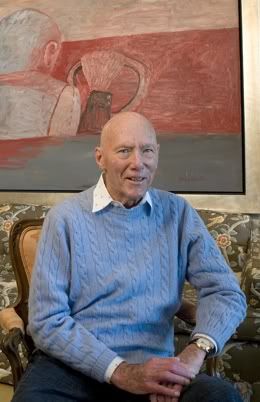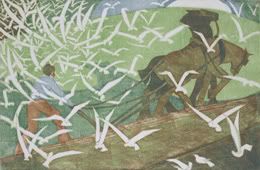|
|
Director's Letter
 | |
It sometimes seems that wherever I go in the world--from London to Buenos Aires--I'm asked existential questions about Detroit. There always seems be some recent piece of coverage in one or another media outlet that restates the same old question (more often than not with a sizable dose of Schadenfreude): can this once mighty industrial hub survive in our purportedly "post-industrial" society? Detroit's towering ruin of a railroad station has taken on the iconic status of a latter-day Coliseum; residential city blocks are depicted as prairieland in the making. There is, of course, no denying this aspect of early twenty-first century Detroit, but the greater Detroit region is still home to more than four-and-a-half million people and considerable thought, effort, and resources of all kinds continue to be focused on various revitalizations. As we heard from Sue Mosey (president of Midtown Inc.) in last month's newsletter, the "Midtown" area, encompassing the Detroit Institute of Arts and a plenitude of other cultural institutions, research hospitals, and a thriving university, clearly represents the most promise, and it seems particularly apt that we present the exhibition Detroit Revealed: Photographs 2000-2010, opening this month in the Albert and Peggy de Salle Gallery of Photography. Detroit Revealed shows a more nuanced and (dare I say it) accurate picture of the state of affairs in Detroit today than is frequently put forth. Seen through the eyes of eight photographers--some resident, others not--today's city becomes a multi-faceted endeavor. We see not just the endlessly aired pictures of failure, abandonment, and despair, but also images that speak of continuity, reinvention, and abiding love.
The entire exhibition is drawn from the DIA's collection, and the idea for Detroit Revealed originated with the DIA's Associate Curator of Photography Nancy Barr. The exhibition represents a number of years of careful collecting on her part, as well as the generosity of the artists and other donors, who gave a number of the works on view.
Talking of the collection, I am often asked where the DIA ranks among U.S. art museums. The statistic that we were the "fifth largest" was true for so long that it's gained an all but ineradicable status. But this is truly a case where size doesn't matter. Among this country's art museums with universal (or encyclopedic) collections, I would say the DIA ranks in the top six, along with the Metropolitan Museum of Art in New York; the Museum of Fine Arts, Boston; the Cleveland Museum of Art; the Art Institute of Chicago; and the Philadelphia Museum of Art. (Note that this list includes neither the National Gallery of Art nor the Museum of Modern Art--both truly great museums but with limited scope.) While the Met and the MFA Boston stand above the others, any exact ranking beyond this is subjective. Chicago, for example, is particularly strong in impressionist art; the DIA's collection of Italian sculpture is the finest in the United States. Cleveland, by contrast, would easily rank highest in Asian art. Overall, most specialists recognize the DIA's particular strength in Renaissance and baroque art in addition to American, early modern, African, and Native American art.

Graham W. J. Beal
Back to top |
|

Exhibitions
 Detroit Revealed Detroit Revealed
Photographs, 2000-2010
October 16, 2011-April 8, 2012
Albert and Peggy de Salle Gallery of Photography
During the past ten years, as Detroit has faced serious challenges and dramatic transformations in the city's industries and landscape, photographers have explored and questioned the complex nature of the community, its history, and its uncertain future. Not intended as a definitive survey, this exhibition looks at the first decade of the twenty-first century and the new millennium with a deliberately eclectic, sometimes predictable, and at others contradictory mix of contemporary work by eight photographers.
Selected for their critical perception, ability to gain rare access to places and people, as well as their diverse perspectives and approaches to photography, the artists in Detroit Revealed present portraits, architectural studies, documentary reportage, and video, with subjects as wide ranging as the factory to the community farm, as well as the unforgettable people and places of Detroit. The exhibition features more than fifty large-scale color and traditional black-and-white photographs by Michelle Andonian, Carlos Diaz, Scott Hocking, Andrew Moore, Alec Soth, and Corine Vermeulen. Video and photographic work by Dawoud Bey and Ari Marcopoulos are also included.
An exhibition catalogue is available in the museum shop.
This exhibition has been organized by the Detroit Institute of Arts. Support has been provided by Quicken Loans and Team Detroit. Additional support has been provided by the City of Detroit. Support for the catalogue has been provided by Furthermore: a program of the J. M. Kaplan Fund.
Above: Carlos Diaz, American; Untitled, 2010; pigment print. From the series Beyond Borders: Latino Immigrants and Southwest Detroit. Museum Purchase, Albert and Peggy de Salle Charitable Trust
Back to top
 Gift of a Lifetime Gift of a Lifetime
The James Pearson Duffy Collection
Through March 18, 2012
Special Exhibitions Central
 | | |
James Pearson Duffy in his Grosse Pointe apartment. Photograph: Tim Thayer
| |
James Pearson Duffy was one of Detroit's most unorthodox collectors, who for forty years, was one of the great characters of the Detroit art scene, with a free-thinking approach to looking at and acquiring art. He was often guided by his intuition, and the collection that resulted represents a variety of interests--from contemporary photography to mixed-media work by Detroit's Cass Corridor artists, to Chinese ceramics. "Jim Duffy meant a great deal to the Detroit art scene in general and to the DIA in particular," said Graham W. J. Beal, DIA director. "In recognition of his lifelong support and sizeable bequest, the DIA's department of contemporary art is named for him. His art collection has greatly enhanced our own, and this exhibition celebrates his life and generosity with some of the artworks he so cherished and left for the enjoyment of us all."
Duffy (1923-2009) owned and operated a successful pipefitting warehouse on Jefferson Avenue in Detroit. When he wasn't working, he was indulging his passion for art, building a collection that includes a wide range of objects. But his main passion was for contemporary art, and he immersed himself in that world in both Detroit and New York. He was the first to buy the now-celebrated 1970s works of Philip Guston, as well as the work of Elizabeth Murray. Among the other New York artists whose works he collected are Joel Shapiro and Linda Benglis.
 It's a Zoo in Here! It's a Zoo in Here!
Prints and Drawings of Animals
Held Over!
Through October 9
Special Exhibitions Central
 | | |
Ethel Spowers, Australian; Birds Following a Plough, 1933; linoleum cut. Founders Society Purchase, John S. Newberry Fund
| |
Visitors have an extra week to enjoy this exhibition of prints and drawings of animals spanning five hundred years and representing artists from around the globe. Included are watercolors; pencil, ink, and chalk drawings; engravings, woodcuts, etchings, lithographs, and screenprints of animals as pets, beasts of burden, or wildlife. Art can be defined as many things, and as this exhibition shows, it seems almost everyone, from Albrecht Dürer to Pablo Picasso, has found it can always be made about animals.
Back to top |
|
Detroit Film Theatre
If you want to be ready for Halloween, the place to be is the DFT, offering two appropriately creepy movies: Eyes without a Face (below) on Friday, October 28, and El barón del Terror (Brainiac) on Saturday, October 29, both showing at 9:30 p.m.
In the French Eyes without a Face, a surgeon's daughter is disfigured in an accident and the doctor and his coldly sinister mistress systematically kidnap young women from the streets of Paris, hoping to successfully graft their faces on to his daughter. Originally released in America in a heavily--you should pardon the expression--butchered version, the restored Eyes without a Face can now be seen as an elegant classic of the horror genre.
In the 1950s and '60s, Mexico's Churubusco Studios produced a series of bizarre, inventive, and increasingly grotesque horror films, culminating in El barón del Terror (Brainiac), the truly incredible, one-of-a-kind tale of a devil-may-care, seventeenth-century baron and notorious playboy. After being burned at the stake for satanic acts, he returns in 1961, three hundred years later, to take revenge on his tormentors by devouring the brains of their descendants using a long, forked tongue--and an occasional spoon. A low-budget cult favorite unique in horror-film history, the grotesque but hypnotic cheesiness of El barón del Terror (released in an edited version in the United States as Brainiac) will have you gasping and laughing in equal measure.
For the complete DFT schedule, call the theater box office at 313.833.3237 or visit the DIA's website. Back to top |
|
Museum Mystery Tour
 | | |
Henry Fuseli, Swiss; The Nightmare, 1781; oil on canvas. Founders Society Purchase with funds from Mr. and Mrs. Bert L. Smokler and Mr. and Mrs. Lawrence A. Fleischman
| |
The museum's popular Halloween Mystery Tours return this year in a new format that includes spooky and haunting works of art in multiple galleries. Pick up a mystery passport at the desk in Rivera Court and follow the trail to the American, European, and contemporary art spaces featuring eerie lighting, sounds in the dark, and secret-spilling guides. It's fun and family friendly, so bring the kids, ages five and older. Costumes are strongly encouraged! The themed galleries are set for visitors young and old on Friday, October 28, from 6 to 9:30 p.m., and Saturday and Sunday, October 29 and 30, from 1 to 4:30 p.m.
Back to top |
|
Canstruction
No orange barrels are needed for this construction project, which turns canned fruits and vegetables into whimsical works of art good enough to eat. Sponsored by the American Institute of Architects, Canstruction is a juried competition for Metro Detroit architects, engineers, and designers to build large-scale sculptures entirely constructed of canned foods. The completed works will be on view in Rivera Court from Wednesday, October 26, through Sunday, October 30, during museum hours. After the exhibition, the sculptures will be disassembled and the canned goods donated to Gleaner's Community Food Bank of Southeastern Michigan.
What the exact canstructions will be in Detroit is a closely guarded secret. At other venues across the country and internationally, the finished creations have featured giant food items, such as a hot dog complete with ketchup and mustard; planes, trains, automobiles, and a Zamboni; and characters from favorite books and movies, including, appropriately enough, the Tin Man from The Wizard of Oz.
Canstruction projects for the 2010-2011 competition year provided more than 2.5 million pounds of nonperishable food to local food banks, pantries, and soup kitchens around the world.
Back to top |
|
|
|
|
Inside|Out Detroit Bicycle Tour
Join a pedal-powered celebration of Detroit and the DIA's Inside|Out program, which brings reproductions of works from the museum's permanent collection to outdoor locations across the metropolitan area. In Detroit, there are twelve works of art installed along the Riverwalk, Dequindre Cut, and Eastern Market. Included in the tour are stops at a poetry reading and at a concert. The eight-and-a-half mile tour begins, rain or shine, at the DIA at 9 a.m. on Saturday, October 15, and returns to the museum by noon. Once back at the DIA, participants can view the original works and preview the new photography exhibition Detroit Revealed with Nancy Barr, associate curator of prints, drawings, and photographs. The bicycle tour is free and includes discounted admission to the museum. Helmets are mandatory.
To register for the Inside|Out Bicycle Tour, go to insideoutride.eventbrite.com. For more information on Inside|Out and maps of installations throughout the metropolitan area, go to the DIA website.
Click here for a chance to win a new bicycle in DTE Energy Foundation's Lead the Pack sweepstakes!
Inside/Out 2011 is sponsored by DTE Energy Foundation.
Back to top |
|
 Double Discount Days Double Discount Days
Want to get a jump on your holiday shopping? Take advantage of Members' Double Discount Days in the museum shop, running from Friday, October 21, through Sunday, October 30. All museum members receive a 20 percent discount on purchases, twice the usual 10 percent. With the discount, buy the Detroit Revealed: Photographs, 2000-2010 exhibition catalogue for $27.99 (regular member price $31.49). Select from other books, decorative art items, textiles, jewelry, educational products, craft kits, and holiday items.
The discount is also available online at www.diashop.org. Back to top |
|
|
Detroit Institute of Arts
5200 Woodward Avenue
Detroit, Michigan 48202
www.dia.org
313.833.7900
Comments or questions about the newsletter? Please contact us: comments@dia.org
ADMISSION
$8 adults, $6 seniors, $4 children
The museum is free for members
Contact the Membership HelpLine at
313.833.7971 or membership@dia.org
For group sales (15 or more) contact 313.833.1292 or dia.org/grouptours
CATERING & RENTALS
Call 313.833.1925 or
catering@dia.org
|
HOURS
Museum
Mon, Tue CLOSED
Wed, Thur 10 a.m.-4 p.m.
Fri 10 a.m.-10 p.m.
Sat, Sun 10 a.m.-5 p.m.
PARKING
Valet parking is available at the Farnsworth entrance on Fridays, Saturdays, and Sundays, during regular museum hours. The price per car is $8.
Lighted, secure self-parking is available in the Cultural Center parking lot, between John R and Brush, behind the museum.
|
CaféDIA
313.833.7966
Wed, Thur 11:30 a.m.-2:30 p.m.
Fri 11:30 a.m.-2:30 p.m., 5-9 p.m.
Sat, Sun 11:30 a.m.-3 p.m.
Kresge Court Coffee Stop
Wed, Thur 10 a.m.-3 p.m.
Fri-Sun 10 a.m.-4 p.m.
Museum Shop
313.833.7944
Open during museum hours
|
|
|
|
|
|